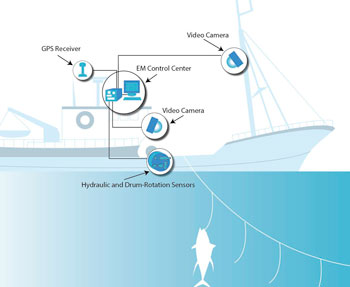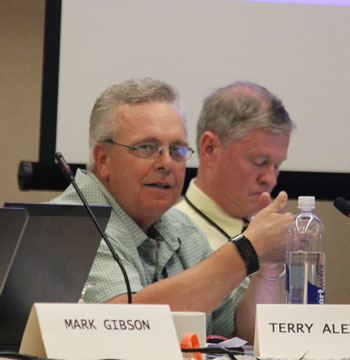Electronic Monitoring Barriers
Still to Be Overcome
by Laurie Schreiber

The onboard set-up for electronic monitoring. Courtesy New England Fishery Management Council
MYSTIC, Conn.—At its April meeting, the New England Fishery Management Council (NEFMC) heard a report from Brett Alger, the electronic technologies coordinator for the National Marine Fisheries Service’s (NMFS) Office of Science and Technology, regarding the development of an electronic monitoring (EM) system aboard fishing vessels.
Cost allocations remained an outstanding issue, particularly as NEFMC examined the question of storage and review of massive amounts of video.
Issues under consideration included the extent of human review of the video, the “training” of computers to review video, the use of video to monitor fishing regulation compliance, data access, ownership, confidentiality, and setting standards across regions. According to a NMFS policy directive, “NOAA will not approve the program if provisions “create an unfunded or unsustainable cost.”
“One concern I have with EM is that video goes out to somebody, they have to review it, and then we get charged a rate on that,” said NEFMC member Terry Alexander. “In the meantime, my crew’s not getting paid for the work they did. Anybody in the fishing game will tell you, the crew wants their money. They don’t want to wait a week or two or three. Has there been any discussion about speeding that process up? I usually settle up the next day with my crew. So I’m concerned about the timing.”
Alger said that, currently, it takes two or three days for the video review process, as the captain sends the video to a third party for review, and the outcome of that review is returned to the captain for his feedback. But the need to speed up that process will be taken into consideration as the program moves forward, he said.
The cost of video storage was raised as a primary concern. Alger said the EM pilot project wasn’t developed with storage costs in mind. “We’ve just been collecting lots of video,” he said. “And now we’re at a point where people are starting to think critically and think about, ‘Do I need to have all four cameras on when I’m transiting, or one camera on? Do I need to have the highest frame rate of video collection if I’m in transiting?’” The program will result in countless terabytes of video, and storage will be a matter of discussion in the coming year, he said.
Noting the directive that NOAA will not approve of program if the cost is unsustainable, NEFMC member Eric Reid said, “So the question is, unsustainable to whom? Unsustainable to the fleet? Let’s take herring, for example. In that fishery, you have a variety of vessels. Some can catch 500,000 pounds of fish in a day. So they have one set of costs, that video review being a portion of the cost. But there are other boats in a different segment of the fishery, and although the capacity of the vessel might be 500,000 pounds, the daily capacity is much less, so the trip might be 12, 14 days long. So the cost, including video, will be substantially higher. So it might be unsustainable for one segment of the fleet, but perfectly sustainble for another portion of the fleet.”
“I think it’s foolish to think the future is going to be more automated,” said NEFMC member Michael Sissenwine. “But obviously there are barriers that have to overcome. Some of those are cultural. Some are legal. How do we advance the technology?” Part of that advancement, he said, includes better information technology, including the ability of EM to identify species.
Sissenwine noted that there have been individual EM projects in individual regions. “There are many problems that are appropriately solved by lots of small-scale regional studies, and others better attacked by national and even international efforts,” he said. “There needs to be more focus on the mega effort….Is that being considered or discussed with any agency?”
Alger said his agency is in the process of creating a national working group on machine learning. The issues of automated review and results costs are “widespread across all our fishery programs,” he said. Many of those issues, he said, have already been solved in other fields, like the military and health care. “So we’re starting to interact with other people who can help solve this problem,” he said. An essential part of automation is having a large image library to help train the computer, he said. To tackle that, the agency is considering installing a camera during its fall trawl survey, to start building an image library.
Ronald Smolowitz, with the Fisheries Survival Fund, said that storing data “in the cloud” could be an inexpensive option while also allowing access to the data. But there are also questions around confidentiality of the data, he said. He suggested that a data firm should be hired to work on these questions.
“I don’t think you should be doing this in-house,” he said. “You need a state-of-the-art data firm. They’re the experts.”
“There’s a much broader discussion happening about data confidentiality and access,” responded Alger. “It’s a very important topic.”

NEFMC member Terry Alexander (left) “One concern I have with EM is that video goes out to somebody, they have to review it. In the meantime, my crew’s not getting paid for the work they did. Anybody in the fishing game will tell you, the crew wants their money. They don’t want to wait a week or two or three. Fishermen’s Voice photo
Geoff Smith with the Nature Conservancy, in Maine, that that decisions around data storage and review rates will impact the costs. “I’m not sure how much leeway the council will have in making those decisions,” Smith said. “Is that cost provision unique to electronic technologies, or does it apply to other data provisions? Is the observer program cost sustainable or not? Do you get to make the decision about whether these costs are sustainable or not?”
Alger said part of the cost equation is the video review rate. “In the case of electronic monitoring, you run the cameras all the time,” he said. But, “do you need to review 100 percent of the data? Can you review 40 percent…in order to meet management goals?...In some case, it’s appropriate to review all of the video, depending on how they use the video. In other cases, it’s appropriate to review less.”
The means that cost sustainability lies within NEFMC’s or NMFS’ purview insofar as NEFMC or NMFS determines the review rate, he added.
One fisherman said her family has been told that the outlay for the video camera alone would be $50,000. “There’s a huge concern that it [costs] will take out such a chunk out of the fleet it’s not even funny,” she said. “If you want few boats that make a lot of money that can put cameras on and happy days, that would be the way to go. But otherwise, it’s really undoable. And from the privacy standpoint – who owns that data? It’s one thing if the fishermen own the data and they send the data for that day to NMFS and say, ‘Here you go, take a look at it.’ And then it has some kind of kill switch. But holding onto that stuff has all kinds of privacy questions.”
With regard to costs, Alger said installation costs for a basic video set-up are from $6,000 to $8,000, with larger boats having higher costs. “A lot of the providers…are working to reduce costs,” he said. “And it’s an investment It’s a system that might last 3-5 years.” With regard to privacy, he said, the agency agrees that fishermen knowing where their hard drives end up and who has access is important.
According to a subsequent NEFMC news release, the total costs for electronic monitoring coverage “will not be reasonably known until the program is fully implemented and operational.” According to the release, NMFS’s final report on a project that tested EM on midwater trawl vessels found that the cameras operated successfully on 97 percent of the footage, and video quality was “excellent” or “good” on 77 percent of the footage. Eight percent of the footage was rated “poor” due to low light, water drops on lens, snow, glare, or condensation, yet even the “poor” footage still was determined to be sufficient for video review. NMFS subsequently recommended that NEFMC approve EM/portside sampling as an option for the herring midwater trawl fishery.
